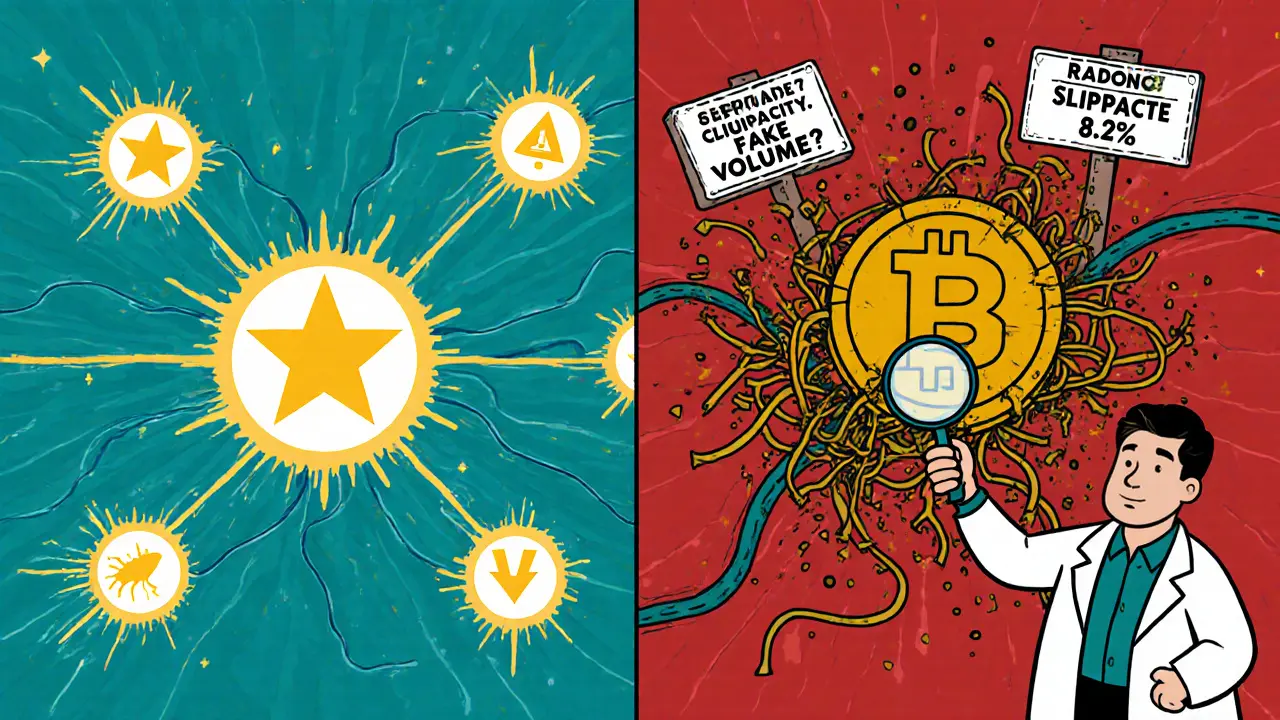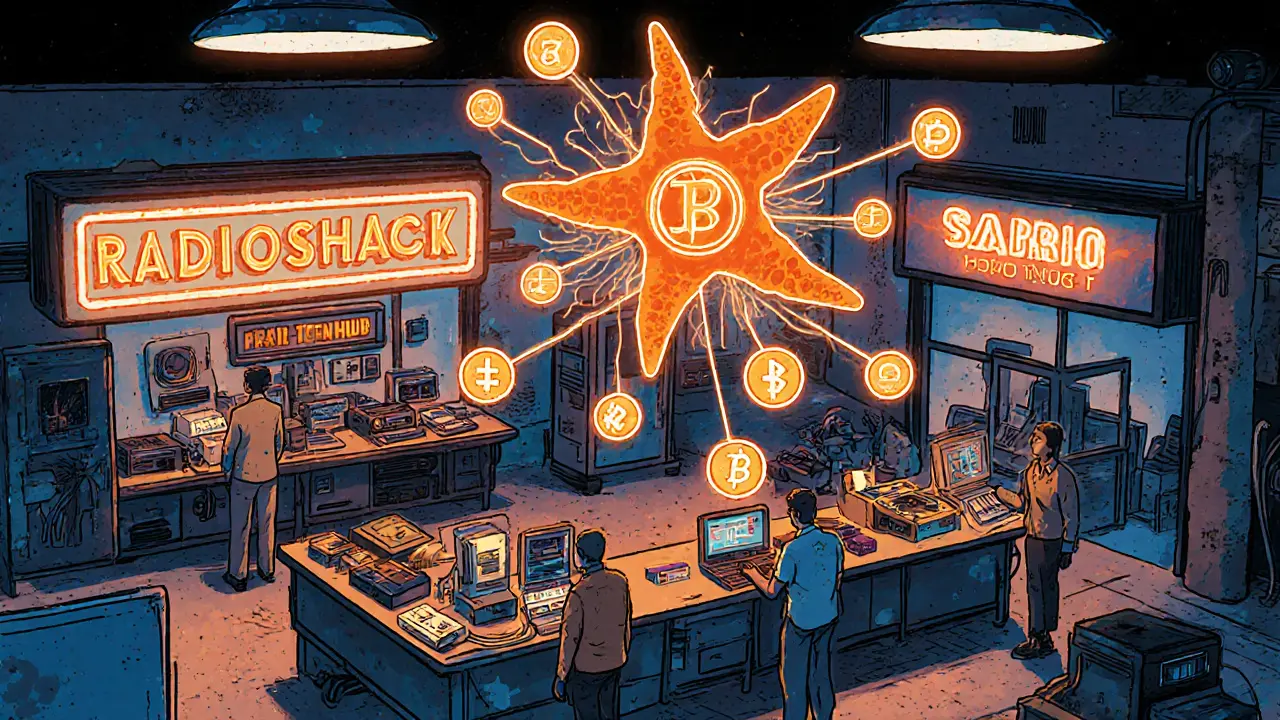RadioShack Swap Slippage Calculator
How Liquidity Affects Your Trade
RadioShack Swap has very low liquidity compared to established DEXs. Based on the article's data, with only $969,800 in total value locked (TVL), larger trades experience significant slippage.
When you hear "RadioShack," you probably think of old electronics stores with blinking LEDs and dusty cables. But in 2025, RadioShack isn’t selling batteries anymore-it’s trying to fix one of the biggest problems in crypto: liquidity fragmentation.
What Is RadioShack (Polygon)?
RadioShack isn’t a traditional crypto exchange like Binance or Coinbase. It’s a decentralized exchange (DEX) built on Polygon, called RadioShack Swap. It uses a unique system called the "Starfish Topology," which centers all trades around a single token: RADIO. Instead of trading directly between two tokens (like USDC to MATIC), you trade through RADIO. Think of it like a hub airport: instead of flying from New York to Tokyo directly, you go through Chicago. In this case, Chicago is RADIO. The idea sounds smart on paper. Most DEXs, like Uniswap, spread liquidity thin across hundreds of token pairs. That means if you want to swap a rare token for another rare token, you might need two or three trades-and pay fees each time. RadioShack claims it cuts that down to one trade by using RADIO as the central node. The protocol’s contract is live on Polygon, Ethereum, Avalanche, and Celo, making it multi-chain from day one.The RADIO Token: Central Node or Single Point of Failure?
The RADIO token is the engine of this whole system. It’s not just a trading pair-it’s the glue holding every trade together. As of October 31, 2025, its price was around $0.000357, with a market cap of roughly $1.08 million. That’s tiny compared to Uniswap’s UNI token ($1.2 billion market cap) or even Polygon’s POL token ($500 million). But here’s the red flag: CoinMarketCap lists a circulating supply of 3.4 billion RADIO tokens, while the total supply is listed as 1 billion. That doesn’t add up. Either the data is wrong, or there’s a misreporting issue-something you don’t want to see in a DeFi project. Stack Money claims a $40 million daily trading volume, but CoinMarketCap shows just $1,217 in 24-hour volume. CryptoInsightPro on Twitter called out the $40M figure as inflated, pointing to on-chain data showing only $1.2M. That kind of disconnect raises serious questions about transparency.How Does It Compare to Other DEXs on Polygon?
Polygon already has powerful DEXs: QuickSwap, PancakeSwap, and SushiSwap. All of them have deep liquidity pools and hundreds of token pairs. QuickSwap alone processes over $18 million in daily volume on Polygon. RadioShack Swap? It’s trading at around $1.2 million per day-barely 6% of QuickSwap’s volume. Liquidity is even worse. RadioShack Swap has just $969,800 in total value locked (TVL). QuickSwap has over $300 million. That means if you try to trade more than $5,000, you’ll likely see 5-10% slippage. One Reddit user reported an 8.2% slippage on a $2,000 USDC to MATIC swap. That’s not just inconvenient-it’s expensive. And token selection? RadioShack Swap lists only 87 token pairs. QuickSwap has over 1,200. If you’re trying to trade a new memecoin or a niche DeFi token, you’re out of luck here.
Who Is This For?
RadioShack Swap isn’t for traders moving large sums. It’s not for institutions. It’s not even for most retail users who want to swap between major tokens quickly and cheaply. It’s for one group: crypto explorers who want to test a novel idea. If you’re curious about liquidity topology, if you want to see how a single-token hub performs in real time, or if you’re holding RADIO and want to stake it, then yes-this might be worth a small experiment. But if you’re looking for reliability, low slippage, or deep liquidity? Go to QuickSwap or SushiSwap. They’re proven, they’re fast, and they have real users.Is the Starfish Topology Actually Better?
The concept behind Starfish Topology isn’t new. Bancor tried it in 2019 with a single-token hub model-and failed. Why? Because if the central token loses value, the whole system gets destabilized. If RADIO drops 30%, every trade on RadioShack Swap becomes more expensive, because the hub is weaker. Dr. Elena Rodriguez from Messari put it bluntly: "It solves a real problem, but it’s a chicken-and-egg situation. You need liquidity to attract users, but users won’t add liquidity until there are enough users." That’s RadioShack’s biggest hurdle. It’s not the tech-it’s the network effect. Uniswap won because everyone used it. RadioShack hasn’t even cracked 2,000 unique wallet interactions in the last 30 days. QuickSwap has over 140,000.What About the Brand?
Let’s be honest: the RadioShack name is brilliant marketing. It’s nostalgic. It’s recognizable. It’s a brand people remember from the 90s. That gives it an edge in awareness that most DeFi projects can’t buy with millions in ads. But branding doesn’t fix bad liquidity. A cool logo won’t make your trade go through faster. A retro logo won’t reduce slippage. And if the project fails to deliver real utility, the nostalgia will fade faster than a 2005 MP3 player.
How to Use RadioShack Swap
If you still want to try it, here’s how:- Install a Web3 wallet like MetaMask or Trust Wallet.
- Switch your network to Polygon (MATIC).
- Get some MATIC for gas fees-around $2 worth is enough.
- Go to radioshackswap.io (verify the URL carefully-scams are common).
- Connect your wallet.
- Swap tokens using RADIO as the intermediary.
Future Roadmap: Hope or Hype?
RadioShack’s roadmap includes integrating Solana and Cosmos by mid-2026 and adding concentrated liquidity (like Uniswap v3) by the end of 2025. That’s ambitious. But without liquidity now, those upgrades mean nothing. If they partner with a major Polygon-based gaming project-like a popular NFT game that needs fast, cheap token swaps-they might gain traction. But as of now, there’s no public announcement of any such partnership.Final Verdict
RadioShack (Polygon) is an interesting experiment-not a replacement for established DEXs. Its Starfish Topology is clever, but it’s still unproven at scale. The liquidity is too shallow. The volume numbers are conflicting. The token supply is confusing. And the competition is overwhelming. If you’ve got $50 to spare and want to see how a new DeFi model performs, go ahead. Swap a small amount. Stake some RADIO. Join the Telegram group. Watch what happens. But if you’re looking to trade regularly, move larger amounts, or find reliable liquidity? Stick with QuickSwap, SushiSwap, or PancakeSwap. They’re not flashy. But they work. RadioShack might be the future. Or it might be a footnote in DeFi history. Right now, it’s too early to tell. But one thing’s clear: don’t bet your portfolio on it.Is RadioShack Swap a real crypto exchange?
Yes, but not in the traditional sense. RadioShack Swap is a decentralized exchange (DEX) built on the Polygon network. It doesn’t hold your funds or act as a middleman like Binance. Instead, it uses smart contracts to let users swap tokens directly, peer-to-peer, using a unique liquidity model centered on the RADIO token.
Can I trade any crypto on RadioShack Swap?
Not really. RadioShack Swap only supports 87 token pairs as of October 2025. That’s far fewer than QuickSwap (over 1,200) or PancakeSwap. You’ll find major tokens like USDC, MATIC, and WETH, but niche or new tokens are likely missing. If your token isn’t listed, you can’t trade it.
Is the RADIO token a good investment?
It’s high-risk. The RADIO token’s value depends entirely on the success of the Starfish Topology. With a market cap under $1.1 million and conflicting data on supply and volume, it’s too early to call it a solid investment. Most DeFi experts warn that single-token hub models are vulnerable to centralization risks. Only invest what you can afford to lose.
Why is there so much confusion about RadioShack’s trading volume?
Because different platforms report different numbers. Stack Money claims $40 million daily volume, but on-chain data from DEXScreener and CoinMarketCap shows only $1.2 million. This mismatch suggests some sources may be inflating numbers or counting non-trading activity. Always check live on-chain data instead of relying on press releases or third-party summaries.
Does RadioShack Swap have mobile apps?
No, RadioShack Swap doesn’t have a dedicated mobile app. You can access it through your mobile browser using a Web3 wallet like Trust Wallet or MetaMask. The interface is responsive, but it’s not optimized for mobile trading. Most users report better experiences on desktop.
How does RadioShack compare to Uniswap?
Uniswap is vastly larger, faster, and more liquid. Uniswap processes over $12 billion in daily volume across all chains. RadioShack’s highest verified daily volume is $1.2 million. Uniswap supports thousands of tokens and has billions in liquidity. RadioShack’s model is different-centralized around RADIO-but it hasn’t proven it can compete at scale. Think of Uniswap as a highway; RadioShack is a small side road with unclear signage.
Is RadioShack Swap safe to use?
The smart contracts have been audited by third parties, which is a good sign. But safety isn’t just about code-it’s about liquidity and community. With low TVL and minimal support, you’re more exposed to slippage, failed transactions, and potential rug pulls if the team abandons the project. Always use small amounts, double-check the website URL, and never connect your wallet to unofficial links.
Can I stake RADIO tokens?
Yes, RadioShack Swap offers staking and yield farming opportunities for RADIO holders. You can lock up your tokens to earn rewards, typically in RADIO or other partner tokens. But with low trading volume and uncertain demand for RADIO, the APY might not be sustainable long-term. Always check the current reward rates before staking.
